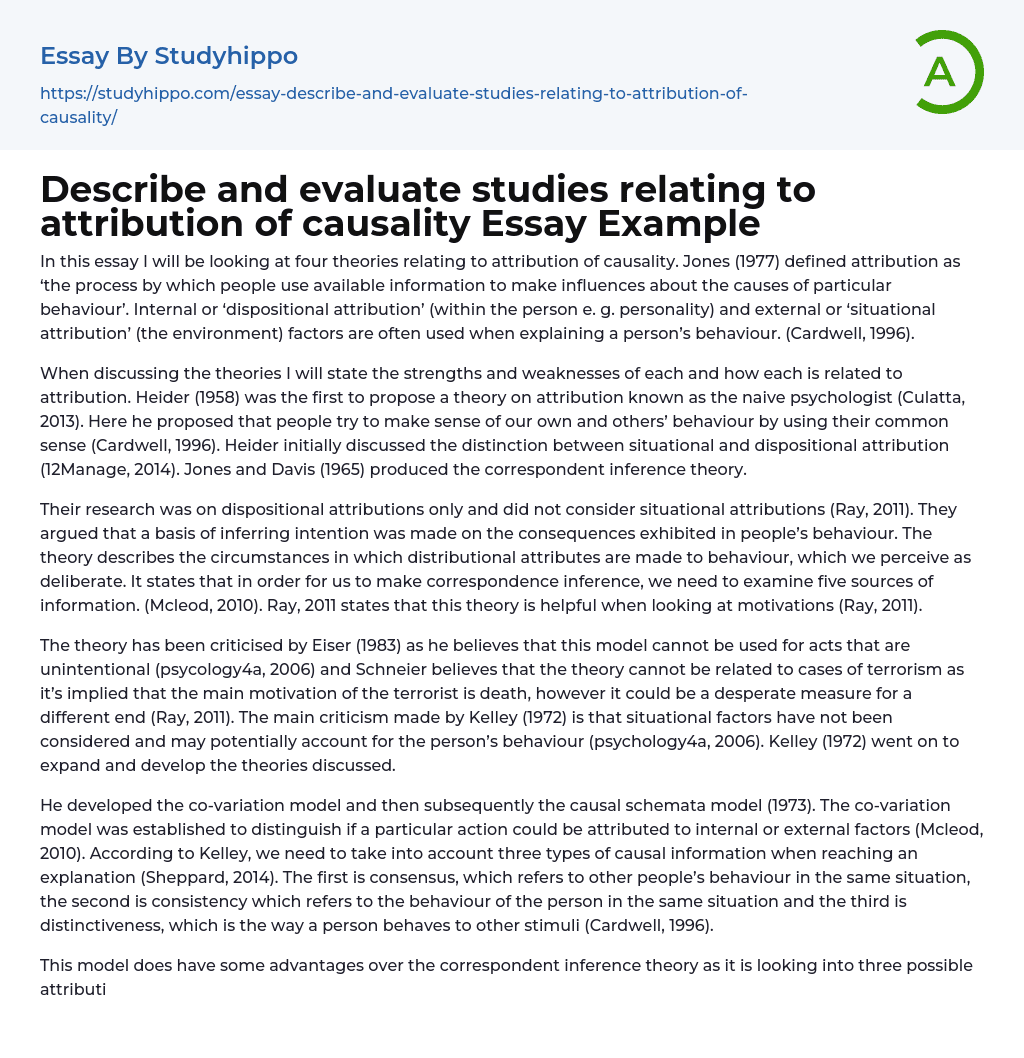

Describe and evaluate studies relating to attribution of causality Essay Example
According to Jones (1977), attribution is the process individuals use to determine the causes of specific behavior by using available information. When explaining someone's behavior, people often consider factors such as internal or 'dispositional attribution' (personality) and external or 'situational attribution' (environment) as stated by Cardwell (1996).
In the discussion of attribution theories, I will examine their strengths, weaknesses, and relevance to attribution. Heider (1958) was the first to propose an attribution theory known as the naive psychologist (Culatta, 2013), which suggests that people rely on common sense to understand their own and others' behavior (Cardwell, 1996). Initially, Heider distinguished between situational and dispositional attributions (12Manage, 2014). Another theory on attribution is the correspondent inference theory developed by Jones and Davis (1965).
Their research focused solely
...on dispositional attributions and overlooked situational attributions (Ray, 2011). They proposed that intentions can be inferred based on the observed consequences of people's behavior. This theory outlines the conditions under which we attribute intentionality to behavior that we perceive as deliberate. According to Mcleod (2010), in order to make correspondence inferences, we must consider five sources of information. Ray (2011) suggests that this theory is particularly useful for examining motivations.
Eiser (1983) criticizes the theory, stating that it cannot be applied to unintentional acts (psycology4a, 2006). Schneier argues that the theory does not apply to cases of terrorism, as it assumes the main motivation of the terrorist is death, though it could be driven by other desperate motives (Ray, 2011). Kelley (1972) criticizes the theory for not considering situational factors that could explain a person's behavior (psychology4a, 2006). Kelley (1972) further expands and develops
the discussed theories.
Kelley developed two models, the co-variation model (1973) and the causal schemata model, in order to determine whether a specific action was caused by internal or external factors (Mcleod, 2010). According to Kelley, there are three types of causal information that should be considered: consensus - how others behave in similar situations; consistency - an individual's behavior in the same situation; and distinctiveness - how a person reacts to different stimuli (Cardwell, 1996).
This model has advantages over the correspondent inference theory as it examines three possible attributions (psycology4a, 2006). Garland et al (1975) criticized this theory by stating that in some cases, people use personality and/or the situation to make attributions (Cardwell, 1996). Nisbett and Ross (1980) also criticized the theory by saying that although it may seem that the covariation principle was applied, the information processing could be completely different (Sheppard, 2014).
Kelley introduced the causal schemata model in response to criticisms of the covariation model. According to Kelley, causal schemata are general conceptions that a person has about how certain causes interact to produce a specific effect. This theory is divided into multiple sufficient causes, which means that there can be many causes for a behavior and any one of them will provide a sufficient explanation. Additionally, there are multiple necessary causes, which means that two or more factors are necessary for behavior attributes to be made (Cardwell, 1996).
Fielder (1982) disagreed with the theory mentioned, arguing that the research in this field is restrictive and that the concept of schemata is too abstract (Sheppard, 2014). According to Fielder, people do not always effectively utilize
all available information when processing information to make attributions, resulting in biases. Ross (1977) also criticized the causal schemata theory by claiming that internal attributions are favored over external ones when explaining someone's behavior, even if both could equally contribute to an explanation (Cardwell, 1996).
In conclusion, multiple studies have examined the process and logic behind attributions. It seems that depending solely on one theory is inadequate for understanding a person's behavior. Differentiating between external and internal factors can be difficult, as shown by Nisbet et al (1973), who found that rephrasing a sentence involving an internal factor could change it into an external factor. When making attributions, various biases may distort our perception of the displayed behavior (Cardwell, 1996).
- Animals essays
- Charles Darwin essays
- Agriculture essays
- Archaeology essays
- Moon essays
- Space Exploration essays
- Sun essays
- Universe essays
- Birds essays
- Horse essays
- Bear essays
- Butterfly essays
- Cat essays
- Dolphin essays
- Monkey essays
- Tiger essays
- Whale essays
- Lion essays
- Elephant essays
- Mythology essays
- Time Travel essays
- Discovery essays
- Thomas Edison essays
- Linguistics essays
- Journal essays
- Chemistry essays
- Biology essays
- Physics essays
- Seismology essays
- Reaction Rate essays
- Roman Numerals essays
- Scientific Method essays
- Mineralogy essays
- Plate Tectonics essays
- Logic essays
- Genetics essays
- Albert einstein essays
- Stars essays
- Venus essays
- Mars essays
- Evolution essays
- Human Evolution essays
- Noam Chomsky essays
- Methodology essays
- Eli Whitney essays
- Fish essays
- Dinosaur essays
- Isaac Newton essays
- Progress essays
- Scientist essays



